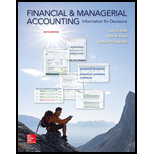
1.
Semiannual cash interest payable
1.
Explanation of Solution
Given,
Rate of interest is 6%.
Time period is 0.5.
Formula to calculate the semiannual cash interest payable,
Substitute $800,000 for value of bonds, 6% for rate of interest and 0.5 for time period.
Hence, semiannual cash interest payable is $24,000.
2.
Number of payments.
2.
Explanation of Solution
Given,
Number of years is 10.
Number of payment in the year is 2.
Formula to calculate the number of payments,
Substitute 10 for number of years and 2 for number of payment in the year.
Hence, number of payments are 20.
3.
Bonds should be issue at par, at discount, and at premium.
3.
Explanation of Solution
Here, the contract rate is less than the market rate. So, the bonds are issued at a discount.
4.
Price of bonds.
4.
Explanation of Solution
|
|
Table |
Table value |
Amount ($) |
Amount ($) |
|
Par value(maturity) |
B.1 |
0.4564 |
800,000 |
365,120 |
|
Interest (annuity) |
B.3 |
13.5903 |
24,000 |
326,167 |
|
Price of bonds |
|
|
|
691,287 |
Table (1)
5.
5.
Explanation of Solution
|
Date |
Account Title and Explanation |
Post. Ref. |
Debit ($) |
Credit ($) |
|
Cash |
691,287 |
|||
|
Discount on bonds payable |
108,713 |
|||
|
Bonds payable |
800,000 |
|||
|
(To record the sold bonds at discount) |
Table (2)
- Cash account is the assets account. Since the cash is received, the value of assets is increased. So, debit the cash account.
- Discount on bonds payable account is the liabilities account. Here, at the time of issue of the bonds discount has been given which decrease the liabilities of the company. So, debit the discount on bonds payable account.
- Bonds payable account is the liabilities account. Bonds has been sold, which increases the liabilities of the company. So, credit the bonds payable account.
Want to see more full solutions like this?
Chapter 10 Solutions
Financial and Managerial Accounting: Information for Decisions
- I am looking for help with this general accounting question using proper accounting standards.arrow_forwardHow much would Kimberly manufacturing report for cost of goods manufacturing ?arrow_forwardI need help finding the accurate solution to this general accounting problem with valid methods.arrow_forward

 AccountingAccountingISBN:9781337272094Author:WARREN, Carl S., Reeve, James M., Duchac, Jonathan E.Publisher:Cengage Learning,
AccountingAccountingISBN:9781337272094Author:WARREN, Carl S., Reeve, James M., Duchac, Jonathan E.Publisher:Cengage Learning, Accounting Information SystemsAccountingISBN:9781337619202Author:Hall, James A.Publisher:Cengage Learning,
Accounting Information SystemsAccountingISBN:9781337619202Author:Hall, James A.Publisher:Cengage Learning, Horngren's Cost Accounting: A Managerial Emphasis...AccountingISBN:9780134475585Author:Srikant M. Datar, Madhav V. RajanPublisher:PEARSON
Horngren's Cost Accounting: A Managerial Emphasis...AccountingISBN:9780134475585Author:Srikant M. Datar, Madhav V. RajanPublisher:PEARSON Intermediate AccountingAccountingISBN:9781259722660Author:J. David Spiceland, Mark W. Nelson, Wayne M ThomasPublisher:McGraw-Hill Education
Intermediate AccountingAccountingISBN:9781259722660Author:J. David Spiceland, Mark W. Nelson, Wayne M ThomasPublisher:McGraw-Hill Education Financial and Managerial AccountingAccountingISBN:9781259726705Author:John J Wild, Ken W. Shaw, Barbara Chiappetta Fundamental Accounting PrinciplesPublisher:McGraw-Hill Education
Financial and Managerial AccountingAccountingISBN:9781259726705Author:John J Wild, Ken W. Shaw, Barbara Chiappetta Fundamental Accounting PrinciplesPublisher:McGraw-Hill Education





